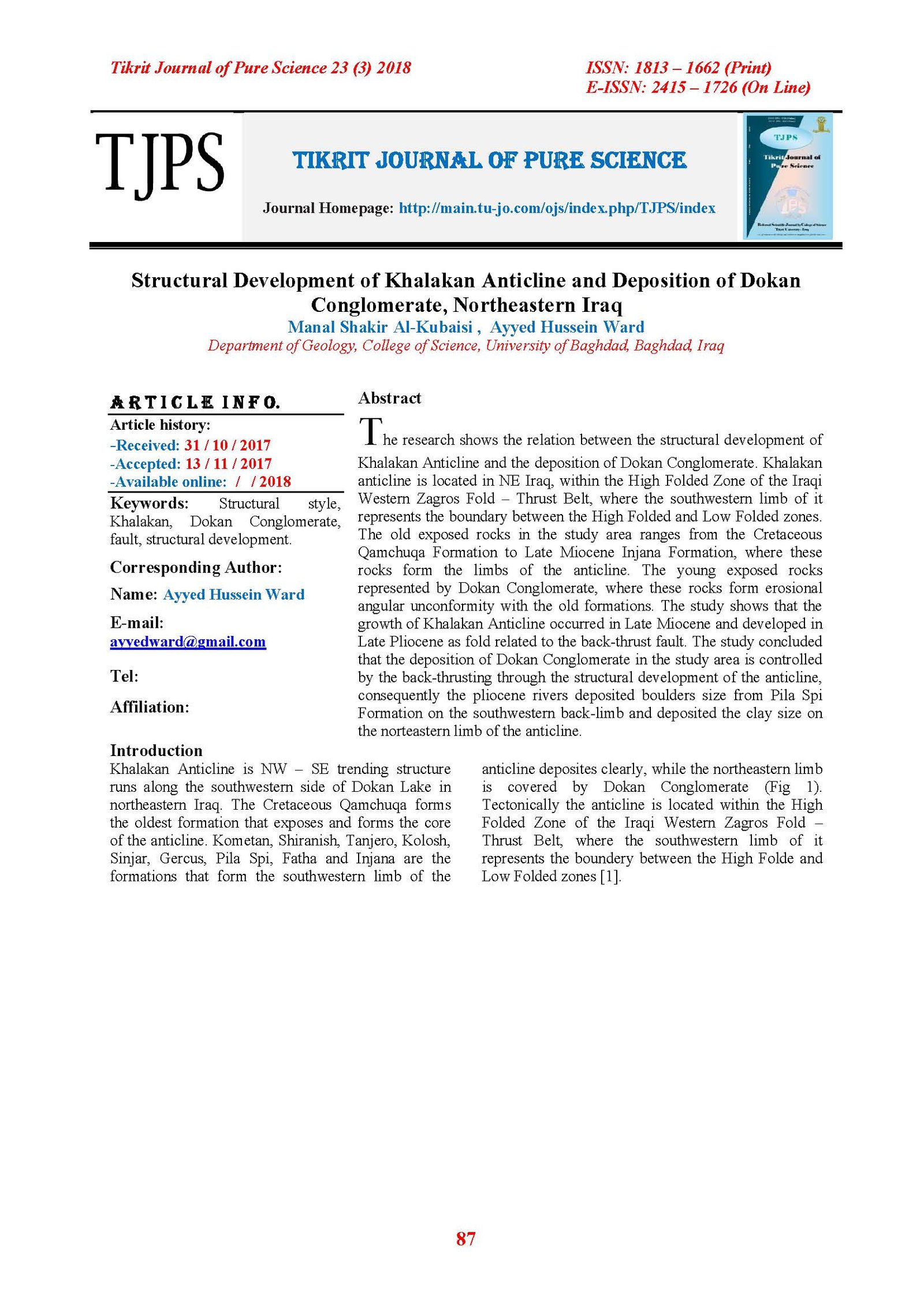Structural Development of Khalakan Anticline and Deposition of Dokan Conglomerate, Northeastern Iraq
Main Article Content
Abstract
The research shows the relation between the structural development of Khalakan Anticline and the deposition of Dokan Conglomerate. Khalakan anticline is located in NE Iraq, within the High Folded Zone of the Iraqi Western Zagros Fold – Thrust Belt, where the southwestern limb of it represents the boundary between the High Folded and Low Folded zones. The old exposed rocks in the study area ranges from the Cretaceous Qamchuqa Formation to Late Miocene Injana Formation, where these rocks form the limbs of the anticline. The young exposed rocks represented by Dokan Conglomerate, where these rocks form erosional angular unconformity with the old formations. The study shows that the growth of Khalakan Anticline occurred in Late Miocene and developed in Late Pliocene as fold related to the back-thrust fault. The study concluded that the deposition of Dokan Conglomerate in the study area is controlled by the back-thrusting through the structural development of the anticline, consequently the pliocene rivers deposited boulders size from Pila Spi Formation on the southwestern back-limb and deposited the clay size on the norteastern limb of the anticline.
Article Details

This work is licensed under a Creative Commons Attribution 4.0 International License.
Tikrit Journal of Pure Science is licensed under the Creative Commons Attribution 4.0 International License, which allows users to copy, create extracts, abstracts, and new works from the article, alter and revise the article, and make commercial use of the article (including reuse and/or resale of the article by commercial entities), provided the user gives appropriate credit (with a link to the formal publication through the relevant DOI), provides a link to the license, indicates if changes were made, and the licensor is not represented as endorsing the use made of the work. The authors hold the copyright for their published work on the Tikrit J. Pure Sci. website, while Tikrit J. Pure Sci. is responsible for appreciate citation of their work, which is released under CC-BY-4.0, enabling the unrestricted use, distribution, and reproduction of an article in any medium, provided that the original work is properly cited.
References
1- Fouad, S, F,A., 2014. Western Zagros Fold-Thrust Belt, part Π: The High Folded Zone. Iraqi Bulletin of Geology and Mining, Special Issue, No.6, p. 53 – 71.
2- Csontos, L., Sasvári, Á., Pocsai, T., Kósa, L., Salae, T. M., and Ali, A., 2012. Structural evolution of the northwestern Zagros, Kurdistan Region, Iraq: Implications on oil migration. Geo Arabia, v. 17, p. 81-116.
3- Bolton, C. M.G., 1958. The geology of Chwarta (K5) and Halabja (K6), Site Invest. Co. Rep. Vol. IXB p.117, Geol. Surv. Min. Invest. Lib. Rep.No.271, Baghdad, Iraq.
4- Karim, K.H. and Taha, Z.A., 2012. The origin of Conglomeratic Limestone "Dokan Conglomerate" in Dokan Area, Kurdistan Region, NE Iraq. Iraqi Bulletin of Geology and Mining, Vol.8, No.3, p. 15 – 24.
5- Sissakian, V.K., Al-Musawi, H.A, Al-Ansari, N. and Knootson, S., 2016. The origin and genesis of the Dokan Conglomerate, NW of Sulaimaniyah, NE Iraq.Earth Sciences and Geotechnical Engineering. vol.6, no. 3, p 35-63.
6- Keller, A.E. and Pinter, N., 2002. Active Tectonics (Earthquakes, Uplift, and landscape) 2nd edit. Prentice Hall Earth Science Series, New Jersey, U. S. A.
7- Ramsey, L.A., Walker, R.T. and Jackson, J., 2008. Fold Evolution and Drainage Development in the Zagros Mountains of Fars Province, Se Iran. Basin Research, Vol.20, p. 23 – 48.
8- Zebari, M., 2013. geometry and evolution of fold structures within the High Folded Zone: Zagros Fold-Thrust Belt, Kurdistan Region-Iraq. University of Nebrasha – Lincoln. 91 P.
9- Al-Kubaisi, M. S., and Abdul Jabbar, M. F., 2015. Effect of Lateral Propagation of Selected Folds on Streams, Sulaimniah Area, NE Iraq. Iraqi Bulletin of Geology and Mining Vol.11, No.1, p 95 – 124.
10- Hunting Aerosurveys lMD. 1957, Topographic Map of Chinaran Ranya, Scale 1:20000. 29, Old Bond ST., London, W1
11- Suppe, J., 1985. Principles of Structural Geology. Prentice-Hall, Inc, New Jersey, 537p.
12- Clevis, Q. 2003. Three-dimensional modelling of thrust-controlled foreland basin stratigraphy, Faculty of Earth Sciences, Utrecht University. 135 pp
13- AL-Azzawi, N.K., 2003. The Structural Development Of Folds Shape in the Foreland Belt of Iraq, and its tectonic implication. Unpub. Ph.D thesis, Mosul University (in Arabic), 163p.
14- Omar, A. A., 2005. An Integrated Structural and Tectonic Study of the Bina Bawi-Safin-Bradost Region in Iraqi Kurdistan. Unpub. PhD thesis, Salahaddin University, 314 p.
